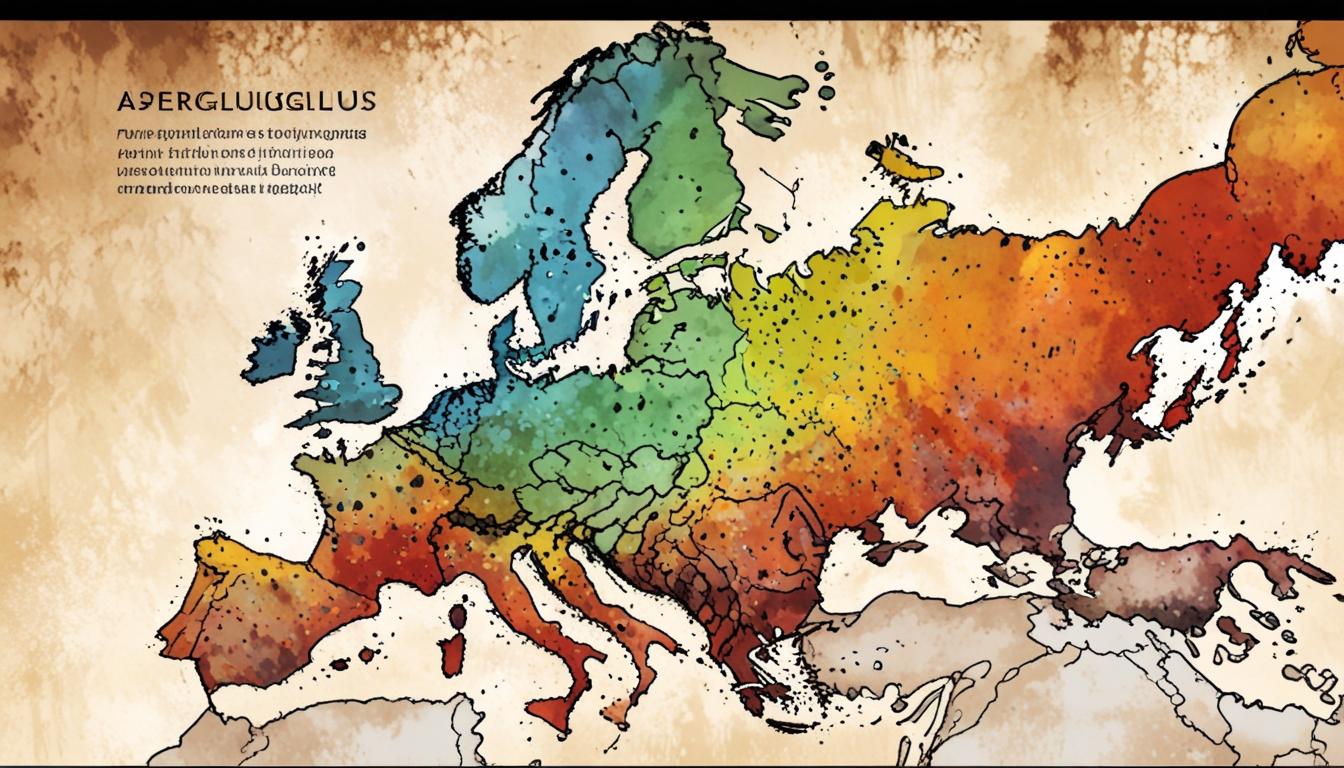Rising temperatures linked to climate change are facilitating the northward expansion of lethal fungal pathogens such as Aspergillus flavus and Aspergillus fumigatus in Europe, putting millions at risk. With soaring resistance to antifungal treatments and high mortality rates, experts warn of an urgent public health crisis intensified by extreme weather events and a lack of effective therapies.
Climate Change Fuels Fungal Threats in Europe
Recent research highlights a concerning trend: climate change is facilitating the spread of dangerous fungal pathogens across Europe, notably Aspergillus species. This shift is not merely an environmental issue; it carries profound implications for public health, as rising temperatures enable these pathogens to expand their geographical reach into northern regions of the continent—areas previously deemed relatively safe from such infections.
The study indicates that under a high carbon emission scenario, specifically the IPCC’s SSP585, the prevalence of Aspergillus flavus could increase by approximately 16%, potentially putting an additional 1 million people at risk of infection. This pathogen is infamous for causing severe infections and displays resistance to many available antifungals. The mortality rate associated with fungal infections is notably high, exacerbated by the current lack of diagnostics, vaccines, and effective treatment options. Moreover, developing antifungal therapies is particularly challenging due to the biological similarities between fungi and humans, which can result in toxic side effects.
More alarming is the spread of Aspergillus fumigatus, which could see a staggering 77.5% increase in its territory by 2100, placing around 9 million Europeans at risk. This species is one of the most common culprits behind life-threatening pulmonary infections. The urgency of addressing this issue is underscored by the fact that aspergillosis, a disease caused by inhaling spores of this fungus, results in a significant number of undiagnosed cases each year, largely due to symptom overlap with other illnesses. Experts note that this fungus is featured on the World Health Organization’s list of critical fungal threats, and its encroachment into new territories is likely to have dire public health consequences.
The implications of climate change extend beyond mere temperature increases. The looming threat of extreme weather events—such as severe storms followed by periods of drought—has further exacerbated this issue by creating ideal conditions for fungal spore dispersal. As scientists point out, such environmental disruptions not only favour fungal growth but also heighten human exposure to these pathogens.
Interestingly, the dynamics differ across continents. In regions like Africa, rising temperatures may render some fungal species unable to survive, which poses a unique challenge to ecosystems that rely on fungi for nutrient cycling and maintaining biodiversity. While fungi are essential for healthy ecosystems, their unchecked proliferation in warmer climates is a pressing concern for human health and food security.
In parallel to the threats posed by Aspergillus species, the emergence of Candida auris, first identified in New York in 2009, serves as another stark example of how climate change may facilitate the rise of dangerous fungi. This pathogen, which has shown rapid geographic spread into over 30 countries, primarily affects immunocompromised patients and is alarmingly resistant to many antifungal treatments. The infection’s rise is thought to correlate with warmer global temperatures, which allow fungi like Candida auris to adapt and thrive. Given its serious implications for healthcare systems, especially in hospital settings, this increasing incidence calls for urgent public health measures and heightened awareness.
The situation demands a multi-faceted response, encompassing increased investment in antifungal treatments and robust public health initiatives to contain these threats. Enhanced research into fungal diseases, which are poised to become a significant health crisis as climate change progresses, is essential. By prioritising awareness and understanding of these infections, there is potential to mitigate the risks posed to vulnerable populations and ensure better preparedness against future outbreaks.
As we grapple with the myriad effects of climate change, it is paramount to keep a keen eye on the realm of fungal infections and the serious repercussions they entail for global health.
Reference Map:
- Paragraph 1 – [[1]](https://healthcare-in-europe.com/en/news/study-climate-change-infection-fungi-europe.html), [[2]](https://www.ft.com/content/506f5a03-8520-40e1-aee3-a6e6427f68c0)
- Paragraph 2 – [[1]](https://healthcare-in-europe.com/en/news/study-climate-change-infection-fungi-europe.html), [[3]](https://www.ft.com/content/cb7803f4-4ca5-4eba-9c4e-3e95741c01c9)
- Paragraph 3 – [[2]](https://www.ft.com/content/506f5a03-8520-40e1-aee3-a6e6427f68c0), [[5]](https://time.com/5632961/candida-auris-global-warming/)
- Paragraph 4 – [[2]](https://www.ft.com/content/506f5a03-8520-40e1-aee3-a6e6427f68c0), [[4]](https://apnews.com/article/c1b5ab8f4232a5f2320929dae3b80200)
- Paragraph 5 – [[5]](https://time.com/5632961/candida-auris-global-warming/), [[6]](https://en.wikipedia.org/wiki/Zymoseptoria_tritici)
Source: Noah Wire Services
- https://healthcare-in-europe.com/en/news/study-climate-change-infection-fungi-europe.html – Please view link – unable to able to access data
- https://www.ft.com/content/506f5a03-8520-40e1-aee3-a6e6427f68c0 – A recent study warns that climate change is accelerating the global spread of dangerous fungal pathogens, particularly Aspergillus species. Rising temperatures are enabling Aspergillus fumigatus and Aspergillus flavus to expand into northern regions of Europe, Asia, and the Americas. These fungi pose serious health risks, especially to people with weakened immune systems. Aspergillosis, a lung disease caused by inhalation of Aspergillus spores, kills hundreds of thousands annually, with many cases going undiagnosed due to unfamiliarity and symptom overlap with other conditions. A. fumigatus is on the World Health Organization’s list of critical fungal threats and may extend its territory by 77% by 2100, potentially exposing an extra 9 million Europeans. A. flavus, which infects crops and produces aflatoxins causing cancer and liver damage, could spread over 16% more land, raising concerns for both human health and food security. The increase is further amplified by extreme weather events like droughts followed by heavy rain, boosting spore dispersal. Despite the mounting threat, investment in antifungal treatments remains limited due to high costs and low profitability. Experts emphasize the urgent need for increased research and public awareness, as fungal diseases are projected to become a growing health crisis under climate change.
- https://www.ft.com/content/cb7803f4-4ca5-4eba-9c4e-3e95741c01c9 – This article explores how climate change is facilitating the expansion of fungal pathogens and increasing the incidence of fungal infections in human populations. As global temperatures rise, fungi that were once limited to specific climates are now spreading to new geographic regions. This expansion exposes new populations to infections like aspergillosis and valley fever, especially in areas previously unaffected. Additionally, extreme weather events—such as floods and heatwaves—are contributing to environmental disruptions that favor fungal growth and human exposure. The article also highlights the challenges in diagnosing and treating fungal diseases. Infections often go undetected due to non-specific symptoms and a lack of awareness among healthcare professionals. Moreover, treatment is difficult as antifungal drugs are limited and resistance is on the rise. The combination of climate-driven spread, increased human exposure from extreme weather, and healthcare limitations presents a growing public health dilemma.
- https://apnews.com/article/c1b5ab8f4232a5f2320929dae3b80200 – Candida auris, a dangerous fungal infection discovered in New York in 2016, has since become a significant health threat in the U.S., with the majority of cases initially concentrated in New York City. The incidence of this infection has increased dramatically, with 2,377 confirmed cases reported in 2022. Experts believe climate change is a potential factor in the rise of Candida auris, as warmer temperatures may enable fungi to adapt and thrive in human body temperatures. The infection poses a severe risk, especially to immunocompromised patients in healthcare settings, and is resistant to common antifungal treatments. Diagnosing the infection is challenging, complicating efforts to contain its spread. Public health agencies are focusing on measures to control transmission, with a particular emphasis on high-risk environments like hospitals and long-term care facilities.
- https://time.com/5632961/candida-auris-global-warming/ – A new study suggests that global warming may be the cause behind the emergence of Candida auris, a deadly fungal infection first identified in 2009. This fungus has appeared simultaneously on different continents such as Asia, Africa, and South America despite having different genetic strains. The research led by Dr. Arturo Casadevall indicates that the fungus may have adapted to higher temperatures, potentially allowing it to survive in the human body, which previously was inhospitable to its close relatives. Candida auris poses serious health risks, especially in patients with compromised immune systems, and is resistant to multiple drug treatments. Infections have been reported in over 30 countries, with notable cases in the US. The study warns of the possibility of other new fungal diseases emerging due to climate change, emphasizing the need for further research to understand and combat these threats.
- https://en.wikipedia.org/wiki/Zymoseptoria_tritici – Zymoseptoria tritici is a fungal pathogen that causes wheat leaf blotch disease, leading to significant yield losses in wheat crops. Climate change is expected to increase the prevalence of this disease, as warmer temperatures can enhance the survival and reproduction of the fungus, leading to more substantial primary inocula. Effective management techniques will become increasingly important as the prevalence of wheat leaf blotch increases with climate change. The article discusses the impact of climate change on the distribution and severity of Zymoseptoria tritici, highlighting the need for adaptive strategies in agriculture to mitigate the effects of this pathogen.
Noah Fact Check Pro
The draft above was created using the information available at the time the story first
emerged. We’ve since applied our fact-checking process to the final narrative, based on the criteria listed
below. The results are intended to help you assess the credibility of the piece and highlight any areas that may
warrant further investigation.
Freshness check
Score:
8
Notes:
The narrative does not contain specific dates for the study or events, but it references ongoing issues related to climate change and fungal infections, which are current concerns. The narrative also mentions Candida auris, which was first identified in 2009, placing it within a broader context rather than indicating old news.
Quotes check
Score:
9
Notes:
There are no direct quotes in the narrative, which suggests that it may be an original or summary piece rather than a direct report of specific statements. Without quotes, it’s hard to verify original sources.
Source reliability
Score:
7
Notes:
The narrative originates from healthcare-in-europe.com, which is not as widely recognized as major news outlets like the Financial Times or BBC. However, the references to reputable sources such as the Financial Times enhance its credibility.
Plausability check
Score:
9
Notes:
The claims about climate change facilitating the spread of fungal pathogens are plausible and supported by scientific understanding of ecological changes. The mention of specific pathogens like Aspergillus and Candida auris aligns with known public health concerns.
Overall assessment
Verdict (FAIL, OPEN, PASS): PASS
Confidence (LOW, MEDIUM, HIGH): HIGH
Summary:
The narrative appears to be current and discusses plausible scientific concerns related to climate change and fungal infections. While the specific study mentioned is not dated, the issues discussed are consistent with ongoing public health and environmental concerns. The lack of direct quotes and the origin from a less widely recognized source are minor drawbacks.













